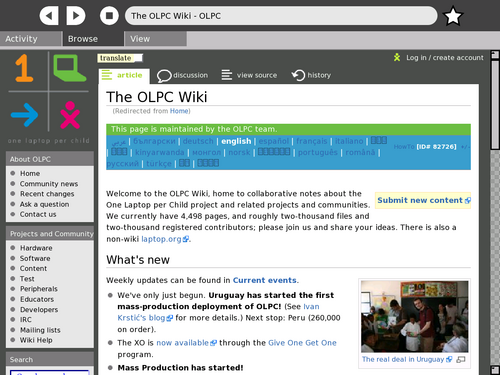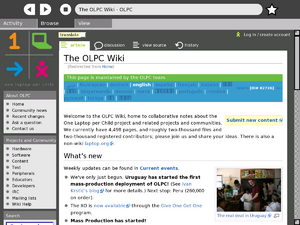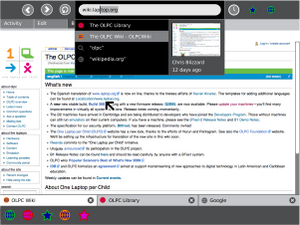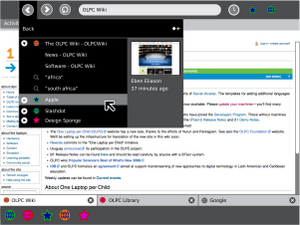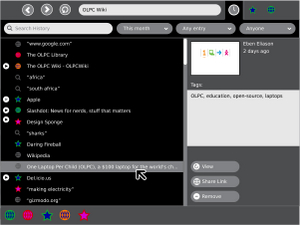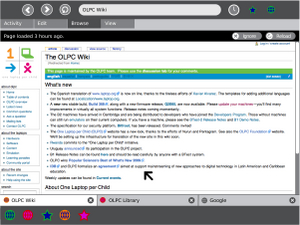Browse
Descrption & Goals
Summary
Goals
Web Sessions
The laptops employ an entirely new approach to Activities and Objects, as evidenced by the Journal. For this reason, we must rethink the basic browsing model and consider "browsing sessions" as the basic Object format. These sessions should work similarly to the way session restore features work in some modern browsers, such as Firefox, only each instance of the Browse activity will maintain its own session data within the Journal. For instance, a child may create one stored session containing tabs for each page she visits daily, and another session containing tabs related to research on her science report. This alternative approach to sessions also goes hand in hand with the collaborative aspects of the Browse activity, since her daily reads session may remain private, while her research session can be shared with the classmates in her study group. Sessions provide a level of organization above what most browsers now provide, separating recreation and work, private and shared.
Smart Caching
Powerful History
Despite the core focus on sessions (or perhaps more importantly because of them), the Browse activity will support cross-session history and bookmarks. This extensive and easily searchable history will span the gap between various sessions, allowing children to share links they found in a private session with their friends later on.
History Entries
Each entry within the history will have a title, a list of associated tags, and a thumbnail for visual recognition. Additionally, each entry will preserve its creation date and creator. The creation date will have the form "n units ago" (eg. "11 minutes ago", "5 days ago", "7 months ago"), thus maintaining a logarithmic temporal granularity just as the Journal itself does. This relative measure will function in parallel to the children's memories, proving far more useful than a more discrete yet less meaningful date.
In addition to these common features, each entry will have a specific type which indicates both where it came from and its importance. Entry types include: bookmarks, shared links, unshared links, and searches. Shared links and bookmarks are always placed in the shared link tray for the browser session, and take on the color of the child who posted it. These colors carry over into the histories, providing visual clues about all of the links and bookmarks that your friends have shared with you and vice versa.
Finally, the presentation of the title will also depend upon how an entry was created. Search entries, for instance, will be labeled with the quoted search string. Pages loaded via explicitly typing a URL will likewise have the quoted URL for a title. On the other hand, entries shared by a friend, or browsed to via hyperlinks, will have their actual page titles preserved in the history, since the URL information needn't be exposed and wouldn't likely be remembered anyway.
Grouping
A primary reason for the uselessness of many browser histories is the shear number of entries that fill it up all too quickly due to most of our browsing habits. While sessions and tabs should, in theory, limit this phenomenon, a better approach is needed. For this reason, the history will support smart grouping of entries. All pages visited in succession within a single top-level domain will be grouped together in collapsed form within the history, making quick scans for any given entry much quicker. Of course, a child may expand any of these groups to reveal the individual pages visited within the domain as well.
Searching & Filtering
A searching and filtering system will allow children to quickly locate entries by name, tags, date, type and creator. By specifying any combination of these parameters, the results list will update to reveal all matching entries.
Collaboration
Link Sharing
Each browsing session will have a tray at the bottom for shared links. This tray will be shared among all of the participants of the activity, and anything shared through it will automatically appear within their histories. Every bookmark that a child makes (with the star button) will automatically be added to the shared links tray; Children may also share links (with the globe button) )that they don't wish to bookmark.
This simple interaction mechanism will provide an entirely new collaborative browsing experience. It could be useful in a classroom setting, allowing a teacher to simply share the links for the day's lessons instead of writing long and complicated URLs on the board. It can also provide a valuable resource for group projects, where each child researches various aspects of a topic and shares the most relevant links with the group. All of the shared links within a session will be preserved with that session. Essentially, any shared link becomes a bookmark unique to that session.
Visual Design
Media
| Document | Description |
|---|---|
| No media | --- |
Screenshots
Development
Feature Requests
Implementation Discussion
Version History
Source
http://dev.laptop.org/git.do?p=web-activity
RPMs
- none available
